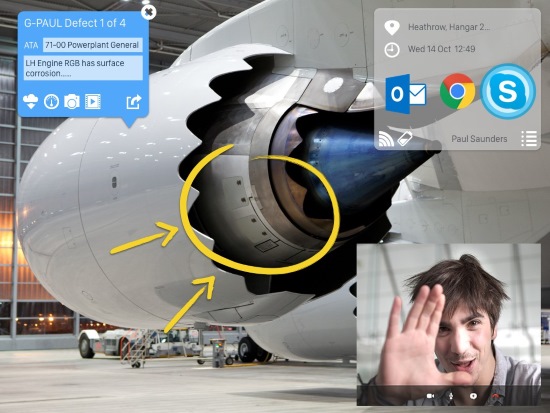Articles
| Name | Author | |
|---|---|---|
| Case Study: Atlas Air – Paperless, that’s the plan | Andy Genao, Senior Manager, Maintenance Planning, and Michael Henry, Director Maintenance Planning, Atlas Air | View article |
| Voice Technology Innovations in MRO | Scott Powell, Senior Manager, Product Marketing, Honeywell | View article |
| The changing face of data | Sander de Bree, CEO, EXSYN | View article |
| Information: how to get what you need | Bijoy Mechery, CEO, and Brent Heath, Senior Vice President, Seabury Solutions | View article |
| Column: How I See IT – The Significance of Telepresence | Paul Saunders, Solution Manager, Flatirons Solutions | View article |
Column: How I See IT – The Significance of Telepresence
Author: Paul Saunders, Solution Manager, Flatirons Solutions
SubscribeColumn: How I See IT – The Significance of Telepresence
Emerging technology in aircraft maintenance and engineering has a tendency to converge on a single use case to solve a specific issue or series of related problems. Take aircraft health monitoring for example. Advances by the OEMs with Big Data and the Internet of Things are all converging around the prognostics and diagnostics of aircraft and engines for purposes of continued airworthiness and maintenance.
At the recent Airline and Aerospace MRO and Operations IT conference in Amsterdam, 49% of my presentation audience who took part in an online poll regarded Data Science and the Internet of Things as the emerging technology likely to make the most significant impact on aircraft maintenance in the next five years. In second place, with 22% of the 156 respondents, was 3D printing. Here again, we see a convergence of technologies and design practices merging to advance and disrupt the supply chain.
However, one use case that seems to be slipping under the radar but which, for me, will have a significant impact on our industry is telepresence. Put a group of Airline and MRO executives in a room together, almost anywhere in the world, and one of the pain points that they will all agree upon is the lack of skilled resources and the problems of employee retention. Fully qualified and experienced aircraft mechanics are an increasingly rare breed. Many of our colleagues are consumed with squeezing every last drop of efficiency out of this finite resource. For me, technology has a part to play in the future of this problem.
Advances in mobility, augmented reality and drones are converging on this problem in a number of ways to tackle the telepresence use case. If you can’t get a limited resource to the maintenance activity, you use technology to bring the maintenance activity to the limited resource. We’ve probably all encountered mechanics resorting to the unauthorized use of FaceTime or Skype to get remote assistance to a problem on the line or in the hangar. Augmented Reality and mobility are combining in new and innovative ways to allow remote technical support staff to supervise or participate in distant checks and maintenance activities in a more controlled manner. One added benefit here is that camera equipped devices are passively recording inspection findings and conversations between technician and supervisor, then storing that content as part of the maintenance accomplishment record for future scrutiny and/or evidence of compliance.

An example of how a telepresence application may look in the near future – here a remote technical support colleague is annotating the user’s surroundings using augmented reality.
Drones and other robots are increasingly being used to support autonomous inspections of aircraft. Again, this technology allows human resources to be more widely distributed. Passive storage of the inspection results are providing additional benefits over a simple ‘no fault found’ recording. Aircraft inspections using invisible wavelengths of light reveal much more than the human eye can ever detect, which is a significant benefit for next generation composite materials. Automated comparisons with prior inspections provide a much clearer picture of an aircraft’s airworthiness than conventional inspections could ever manage.
The big problems and challenges are never overcome with a single silver bullet. It takes the convergence of several innovations and advancements in technology capability to deal with the, often, multiple elements that make up the big picture. And, while OEMs are investing in Big Data and the Internet of Things to improve the availability and maintainability of their aircraft and engines, I’m keeping my eye on smaller advances in mobility and autonomous inspection to address the more human issue of telepresence… or at least that’s how I see IT.
Contributor’s Details
Paul Saunders
 Paul is a technology specialist who has been working in aviation IT since 1998 with expertise in software design and mobility, having worked on apps used by pilots and engineers. In the adoption of emerging technology in aerospace, particularly mobility, Paul is a visionary and geek. He joined the TechSight/X team in 2013 where he serves as a global product manager spearheading flight operations, engineering services and mobile solutions.
Paul is a technology specialist who has been working in aviation IT since 1998 with expertise in software design and mobility, having worked on apps used by pilots and engineers. In the adoption of emerging technology in aerospace, particularly mobility, Paul is a visionary and geek. He joined the TechSight/X team in 2013 where he serves as a global product manager spearheading flight operations, engineering services and mobile solutions.
Comments (0)
There are currently no comments about this article.

To post a comment, please login or subscribe.